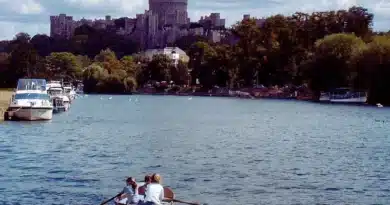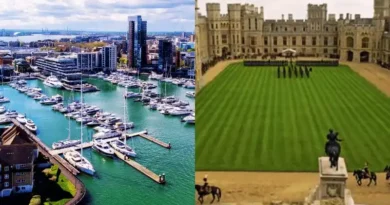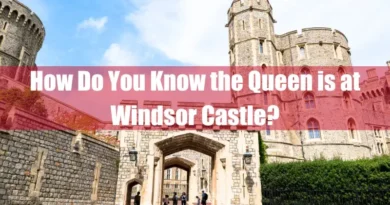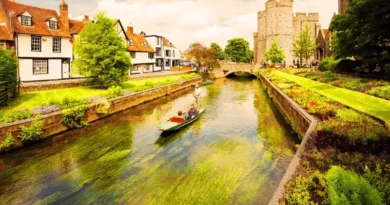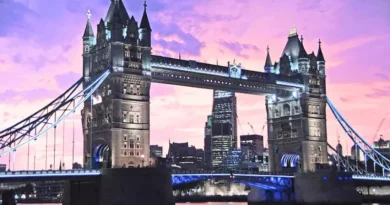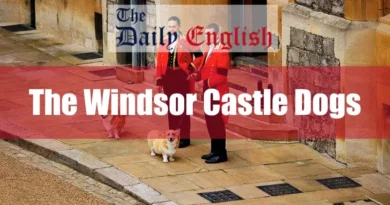How Many Acres is Windsor Castle?
Windsor Castle covers an area of approximately 13 acres (about 5.2 hectares). It includes the upper ward, lower ward, quadrangle, gardens and grounds and military and residential buildings.
Windsor Castle, located in Berkshire, England, is one of the world’s most iconic and historically significant castles. The castle occupies a vast area of about 13 acres (approximately 5.2 hectares), making it the largest occupied castle in the world. This extensive area includes buildings, gardens, and courtyards reflecting nearly a thousand years of British royal history.
Key Takeaways
| Key Points |
|---|
| Windsor Castle is the largest occupied castle in the world, covering 13 acres (5.2 hectares). |
| Its rich history is reflected in its structure, with each section showcasing a different period. |
| It originated as William the Conqueror’s 11th-century fortress and evolved into a grand royal palace. |
| The castle comprises multiple sections: the Upper Ward (State Apartments and private quarters), Lower Ward (St. George’s Chapel), Quadrangle (central courtyard), gardens and grounds, and military/residential buildings. |
| Monarchs such as Charles II and George IV renovated the castle to reflect their preferences. |
| Today, Windsor Castle serves as an important royal residence for the British monarch and hosts state events and ceremonies. |
| Millions of tourists visit annually to admire its history, architecture, and royal artifacts. |
| The castle boasts a large floor area of approximately 54,835 square metres (590,239 square feet). |
Breakdown of the 13 Acres
The 13 acres of Windsor Castle encompass several key components that make up the entirety of this historic site:
- The Upper Ward: This is the central part of the castle and contains the State Apartments, which are the primary ceremonial rooms of the castle used for official functions and state visits. The Upper Ward also includes the monarch’s private apartments and the Round Tower, the most prominent feature of Windsor Castle, which houses the Royal Archives.
- The Lower Ward: Situated below the Upper Ward, the Lower Ward contains St. George’s Chapel, a masterpiece of Gothic architecture and the spiritual home of the Order of the Garter. The Lower Ward also includes the Dean and Canons of Windsor residences, responsible for the chapel’s services and upkeep.
- The Quadrangle: A central, open courtyard around which the Upper Ward buildings are arranged. This area is used for various ceremonial purposes, including the annual Garter Day procession, and is a significant aspect of the castle’s layout, contributing to its expansive 13-acre size.
- The Gardens and Grounds: The castle grounds include beautifully landscaped gardens and terraces, which enhance the castle’s grandeur and provide stunning views of the surrounding areas. The East Terrace Garden, for example, is a private garden that was opened to the public for the first time in 2020
- The Military and Residential Buildings: Besides its ceremonial functions, Windsor Castle also houses a military garrison and residential quarters for the royal staff and guests. These buildings are part of the castle’s operational side, which maintains the day-to-day running of the estate.

Historical Significance of the 13 Acres
The 13-acre size of Windsor Castle is not just a measure of its physical expanse but also a testament to its historical development and significance. Each section of the castle reflects different periods of English history, from its origins as a fortress built by William the Conqueror in the 1070s to its evolution into a grand royal palace.
Over the centuries, various monarchs have expanded and renovated the castle to suit their needs and tastes. For example, during the reign of Charles II in the 17th century, the State Apartments were redesigned to showcase the baroque style. In contrast, in the 19th century, George IV added the George IV Gate, enhancing the castle’s neo-Gothic appearance.
The Castle Today
Today, Windsor Castle remains an important ceremonial and royal residence. It serves as one of the principal official residences of the British monarch and is often used for state banquets, official events, and ceremonies. The castle attracts millions of visitors annually, who admire its rich history, stunning architecture, and royal artefacts.
The castle underwent significant restoration following a devastating fire in 1992, which damaged several important rooms, including St. George’s Hall and the Grand Reception Room. The restoration took five years to complete. Windsor Castle was restored to its former glory using traditional materials and techniques to preserve its historical integrity.
Conclusion
Windsor Castle’s 13 acres blend historical architecture, ceremonial spaces, and functional areas, creating one of the world’s most famous and longest-inhabited royal residences. Each section of the castle, from the majestic State Apartments and St. George’s Chapel to the lush gardens and military quarters, contributes to this historic estate’s overall size and significance.
The castle’s large area reflects its rich history and role as a living symbol of the British monarchy.
FAQ
How many acres does Windsor Castle cover?
Windsor Castle spans approximately 13 acres (5.3 hectares), encompassing its buildings, courtyards, and gardens.
What is the size of Windsor Castle’s estate?
The Windsor Estate covers about 16,000 acres (6,400 hectares), including Windsor Great Park and other lands.
How large is Windsor Great Park?
Windsor Great Park spans approximately 5,455 acres (2,202 hectares), featuring woodlands, gardens, and open spaces.
What is the area of the Home Park at Windsor?
The Home Park covers about 655 acres (265 hectares) and includes parkland, farms, and estate cottages.
How much land does the Long Walk at Windsor encompass?
The Long Walk is a 2.65-mile (4.26 km) avenue extending south from Windsor Castle, lined with trees and open parkland.
What is the total acreage of Windsor Castle and its immediate grounds?
Including the Castle’s 13 acres and the adjacent Home Park’s 655 acres, the immediate grounds cover approximately 668 (270 hectares).
How does Windsor Castle’s size compare to other royal residences?
Windsor Castle is the world’s largest and oldest inhabited Castle, covering 13 acres, surpassing many other royal residences in size and historical significance.
What is the floor area of Windsor Castle?
The Castle has a floor area of approximately 54,835 square meters (590,239 square feet), making it one of the largest inhabited castles globally.
How extensive are the gardens within Windsor Castle?
The Castle’s gardens are relatively limited due to their elevated position, but they are part of the 13-acre estate, offering landscaped areas and terraces.
What is the size of the private apartments within Windsor Castle?
While the exact size of the private apartments is not publicly disclosed, they are part of the extensive residential and state rooms within the Castle’s 13-acre footprint.
How large is St George’s Chapel at Windsor Castle?
St George’s Chapel, located within Windsor Castle, is a significant Gothic structure measuring over 315 feet (96 meters) in length. Founded in 1475, the chapel was completed in 1511 and is renowned for its Perpendicular Gothic architecture.
What is the area of the State Apartments in Windsor Castle?
The State Apartments are a major feature of the Castle, though their exact area is not specified within the overall 13-acre estate.
How much of Windsor Castle’s area is open to the public?
Significant portions, including the State Apartments and St George’s Chapel, are open to visitors, though specific acreage accessible is not detailed.
What is the size of the Round Tower and its base at Windsor Castle?
The Round Tower at Windsor Castle stands approximately 65.5 metres (215 feet) tall. It is situated atop an artificial hill, or motte, about 50 feet (15 metres) high. The tower’s base is not perfectly cylindrical due to the irregular shape of the motte beneath it. In the early 19th century, architect Jeffry Wyatville extended the tower upwards by 30 feet (9 metres) to create a more imposing silhouette.
How extensive is the Lower Ward of Windsor Castle?
The Lower Ward includes St George’s Chapel and other buildings, forming part of the Castle’s 13-acre area, though specific measurements are not provided.
What is the length of the North Terrace at Windsor Castle?
The North Terrace offers views over the surrounding landscape; however, its precise length is not detailed in the available sources.
How large is the Quadrangle in Windsor Castle’s Upper Ward?
The Quadrangle in Windsor Castle’s Upper Ward is a spacious courtyard, approximately 100 meters (328 feet) in length and 50 meters (164 feet) in width, covering an area of about 5,000 square meters (53,820 square feet). Significant structures, including the Round Tower to the west, the State Apartments to the north, and various royal and state apartments to the east and south, surround it. At its centre stands an equestrian statue of King Charles II, installed in 1680.
What is the size of the Moat Garden at Windsor Castle?
The Moat Garden, located beneath the Round Tower, is part of the Castle’s landscaped areas, though its specific size is not detailed.
How extensive is the visitor route through Windsor Castle?
Windsor Castle, perched atop a steep hill, features an extensive visitor route covering significant distances; comfortable footwear is recommended. A typical visit lasts 1.5 to 2 hours, though many guests extend their exploration to 2.5 to 3 hours to fully appreciate the State Apartments, St George’s Chapel, and other attractions. Additionally, the Long Walk, a picturesque avenue extending approximately 2.5 miles, offers a scenic experience for those wishing to explore the castle’s surroundings further. As Windsor Castle is a working royal palace, certain areas may be closed on short notice; checking the official website for the latest information before planning your visit is advisable.
What is the area of the Semi-State Rooms in Windsor Castle?
The Semi-State Rooms are additional private apartments within the Castle, included in the 13-acre footprint, though their specific area is not publicly disclosed.




